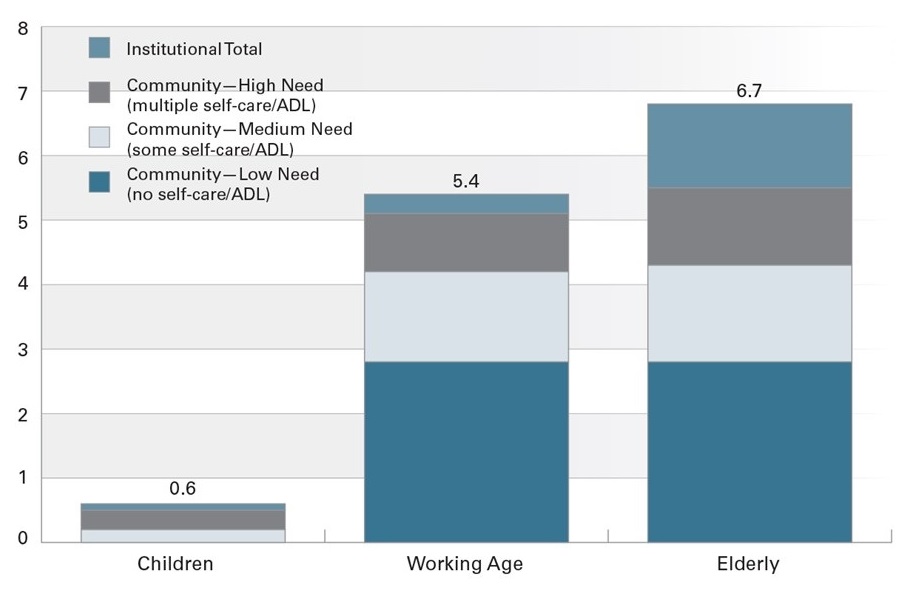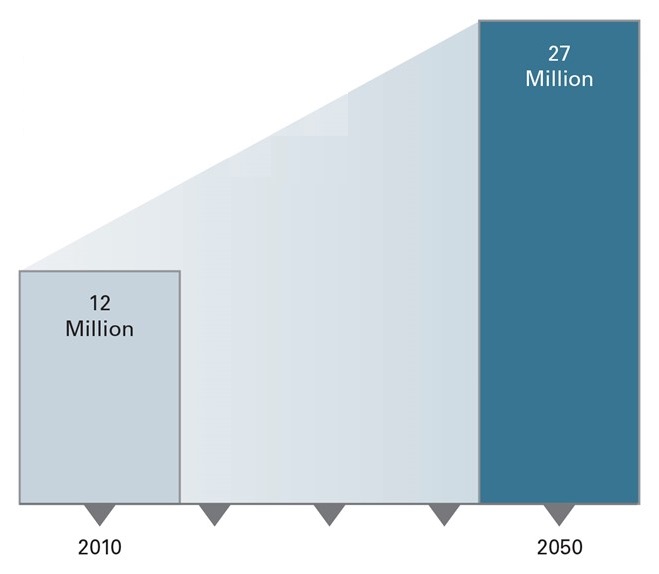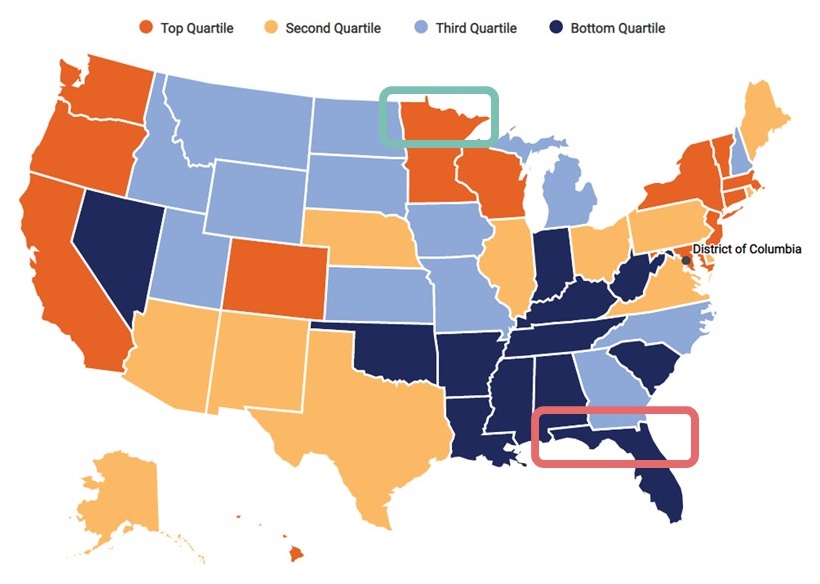Tuesday, November 10, 2020
Printer Friendly Version in PDF Format (10 PDF pages)
Past Efforts to Expand Access to Long-Term Services & Supports
Gretchen Alkema, Ph.D., Vice President, Policy and Communications, The SCAN Foundation
U.S. Aging Policy Milestones
- Daily Living Security
- Public:
- ACA Opportunities (2010)
- Medicaid (1965)
- Older Americans Act (1965)
- Private:
- LTC Insurance (1970s)
- Family / Friends / Neighbors
- Public:
- Income Security
- Public:
- Social Security (1935)
- SSDI/SSI (1956/1972)
- Private:
- Defined Benefit
- 401K -- 403B
- Private Disability Ins.
- Earned Income
- Public:
- Health Security
- Public:
- ACA (2010)
- Medicare/ Medicaid (1965)
- VA (1930)
- Private:
- Medigap (1965)
- Retiree Health Insurance
- Pub/Priv:
- Medicare Managed Care (1982; 1997; 2003)
- Public:
2013 Commission on Long-Term Care
- Commission's charge: To create a plan to...
- Establish, implement, and finance a comprehensive, coordinated, and high-quality LTSS system
- Ensure availability of LTSS to:
- Older adults
- People with substantial cognitive or functional limitations
- Others needing ADL assistance
- Those who plan for future needs
- http://www.ltccommission.org/
Call to Action
- 12+ million need LTSS
- Diverse population: almost half under age 65
- Most living in their homes and in the community
- Most are assisted by family caregivers
- Many get their needs met
- Key problems more severe with population aging:
- Paid LTSS is expensive & long periods can be catastrophic
- Most retirees not adequately prepared for costs
- Family caregivers provide most care
- Financially and emotionally stressful
- Availability will decline in the future
- Direct care workforce capacity, quality, & training
- Paid LTSS: highly fragmented & difficult to access
- lack focus/coordination to get best outcomes
- can be expensive and inefficient
- Future growth in LTSS need with population aging
- Major strain on federal/state budgets
Population Needing LTSS, by Age Group and Level of Need
 |
| SOURCE: S. Kaye, data from 2012 NHIS, 2010 Census, Nursing Home Data Compendium 2010. |
The Number of Americans Needing Long-Term Care Will More than Double by 2050
 |
| SOURCE: S. Kaye, C. Harrington, and M. Laplante (2010), Analysis of 2005 SIPP, 2007 NHIS, 2007 ACS, 2004 NHHS, and the 2005-2006 Medical Expenditure Survey. |
Call to Action
- Projected increase in LTSS need will confront significant resource constraints due to current & projected fiscal challenges
- New care integration, technology, & innovative workforce strategies needed to reduce costs & improve outcomes
- Creative financing solutions needed to insure risk & encourage savings
- More accessible & sustainable Medicaid safety net needed
Vision for Future LTSS System
- Service Delivery
- Person- & family-centered
- Balance of options: HCBS/Institutional
- Integrated medical & LTSS
- Effective: outcomes focused
- Efficient: financially sustainable
- Financing
- Full array of LTSS financing options
- Balance of public/private financing
- Protects against catastrophic costs
- Enables individual preparation
- Safety net for those in most need
- Workforce
- Attracts & retains trained workers
- Adequately-sized
- High quality, person-centered care across LTSS settings
Recommendations: Service Delivery
- Rebalancing: incentivize states to balance HCBS & institutional care
- Care Integration
- Align incentives to integrate person-centered care
- Establish a single point of contact for LTSS.
- Use technology to mobilize and integrate resources
- Create livable communities
- Uniform Assessment: implement a standardized assessment tool to produce a single care plan
Recommendations: Service Delivery
- Consumer Access: expand "No Wrong Door" to provide enhanced options counseling
- Quality: accelerate development of LTSS quality measures for HCBS and make them available to consumers
- Payment Reform: promote payment based on the service rather than the setting
Recommendations: Workforce
- Family Caregiving
- National strategy to maintain & strengthen family caregiving
- Include family caregivers in needs assessment & care planning
- Encourage expansion of caregiver interventions
- Paid Workforce
- Encourage revision of scope of practice to permit delegation with supervision to direct care workers
- Enable criminal background checks for LTSS workforce
- Direct Care Workforce
- Create meaningful ladders & lattices for career advancement
- Integrate direct workers in care teams
- Collect detailed data on LTSS workforce
- Encourage standards & certification for home care workers
Financing: Vision and Alternative Approaches
- Common Vision: A balance of public and private financing to insure the most catastrophic expenses, encourage savings and insurance for more immediate LTSS costs, and provide a strong safety net for those without resources.
- LTC Commission did not agree on a single approach, but offered two approaches that might achieve the common vision
- Private options to strengthen financing
- Social insurance
Recommendations: Financing
- Medicaid Improvement
- Demo to provide LTSS to those w/ disabilities to stay employed
- Assist states to achieve greater uniformity in Medicaid buy-in programs
- Medicare Improvement
- Eliminate 3-day prior hospitalization requirement for skilled nursing facility stay
- Reconsider "homebound" requirement for home health care
- Savings
- Allow individuals with disabilities & their families to set up section 529 savings funds
Long-Term Services & Supports State Scorecard, 2020 Edition
- Advancing Action, 2020: A State Scorecard on Long-Term Services and Supports for Older Adults, People with Physical Disabilities, and Family Caregivers
- 2020 Long-Term Services and Supports State Scorecard Webcast
High-Performing LTSS System
- Five dimensions of LTSS performance, constructed from 26 individual indicators.
- Affordability and Access
- Nursing Home Cost
- Home Care Cost
- Long-Term Care Insurance
- Low-Income PWD with Medicaid
- PWD with Medicaid LTSS
- ADRC/NWD Functions
- Choice of Setting and Provider
- Medicaid LTSS Balance: Spending
- Medicaid LTSS Balance: Users
- Self-Direction
- Home Health Aide Supply
- Assisted Living Supply
- Adult Day Services Supply
- Subsidized Housing Opportunities
- Quality of Life and Quality of Care
- PWD Rate of Employment
- Nursing Home Residents with Pressure Sores
- Nursing Home Antipsychotic Use
- HCBS Quality Benchmarking
- Support for Family Caregivers*
- Supporting Working Family Caregivers
- Person- and Family-Centered Care
- Nurse Delegation and Scope of Practice
- Transportation Policies
- Effective Transitions
- Nursing Home Residents with Low Care Needs
- Home Health Hospital Admissions
- Nursing Home Hospital Admissions
- Burdensome Transitions
- Successful Discharge to Community
- Affordability and Access
ADRC/NWD - Aging and Disability Resource Center/No Wrong Door
HCBS - Home- and Community-Based Services
LTSS - Long-Term Services and Supports
PWD - People with Disabilities
* Support for Family Caregivers Dimension evaluated across 12 individual policies, which are grouped into four broad categories.
SOURCE: Long-Term Services and Supports State Scorecard, 2020.
State Rankings Overall, 2020
 |
Key 2020 Scorecard Findings
- States made progress since 2017, but status quo dominates
- Even highest-performing states have room for improvement
- Top- & bottom-ranked states have remained consistent
- States showed significant decline in long-term care insurance policies
- Affordable/accessible housing remain significant unmet need
The SCAN Foundation
- Our Vision: A society where older adults can access health and supportive services of their choosing to meet their needs.
- Our Mission: To advance a coordinated and easily navigated system of high-quality services for older adults that preserve dignity and independence.
- Sign up for email alerts at https://www.thescanfoundation.org/
- Follow us on Twitter at http://twitter.com/TheSCANFndtn
- Follow us on Instagram at https://www.instagram.com/thescanfndtn/
- Find us on Facebook at http://www.facebook.com/pages/The-SCAN-Foundation/147552491923468
- Find us on LinkedIn at https://www.linkedin.com/company/the-scan-foundation/
